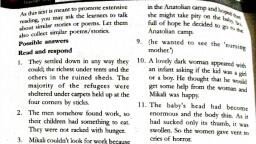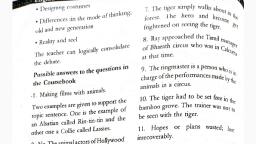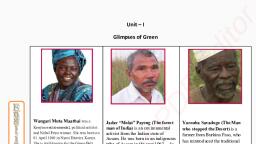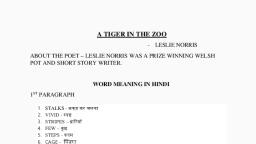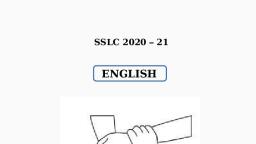Page 1 :
Lesson - 3, William Wordsworth, one of the major figures, in the history of English literature, was born on, 07 April 1770 in Cockermouth, United, Kingdom. In collaboration with his friend, Samuel Taylor Coleridge, he published a, collection of poems titled ‘Lyrical Ballads’ in, 1798, which marked the beginning of the, Romantic Age in the English literature. His, semi auto-biographical work ‘The Prelude’ is, considered to be his masterpiece. He was, Britain’s poet laureate from 1843until his death., He passed away on 23 April 1850., , Glossary:, 1., 2., 3., 4., 5., 6., 7., 8., 9., 10., 11., 12., 13., , Blended: mixed; (here) various, Notes: sounds; songs of birds (expressions of different emotions), Sate : satisfy; (here) sat, Grove: a small wood, Reclined: sat or lay in a leaning or resting position (calmly and comfortably), Her fair works: Nature’s honest and indiscriminating world. (Nature is personified and called ‘her’.), To her fair works did nature link/ The human soul = Nature has linked the human soul to her (Nature’s), fair world of activities., That through me ran: that link passed through me (passed through any human being). Man and Nature are, so strongly linked., Grieved my heart: made my heart sad, What man has made of man: man has created disharmony among his fellowmen and destroyed nature., (People have done all wrong-doings among themselves as well as to nature)., Primrose tufts: bunches of the flower primrose, Periwinkle: an evergreen plant with bluish flowers, Trail (v): (here) grow slowly up and expand; creep [(����) ���n, � ], , 14. Wreath: ornamental flower circle, (here) flowers grown thickly in groups., 15. Through primrose…. /…trailed its wreaths: in nature all kinds of plants and flowers grows and exist in, perfect harmony., 16. Hopped: jumped in joy, 17. Their thoughts I cannot measure: I cannot measure or imagine how much the birds’ pleasure is., 18. Least motion: every silly movement, 19. Budding twigs: slender shoots growing from a branch; new, tender branches, 20. Fan: (here) tender leaf, 21. And I must think,… / ….pleasure there: What all I can do is that I must admit the fact that there is pleasure, everywhere in nature., 22. If this belief… / …Nature’s holy plan: If the pleasurable co-existence is the Divine plan or Nature’s rule, (why man alone broke this rule!), 23. Lament: cry expressing extreme grief; complain, , www.apluseducare.blogspot.com or Watsapp 9072708051
Page 2 :
24. Have I not reason…. / …made of man?: (when everything in nature exists in harmony, man alone creates, disharmony among his fellow-men and destroys nature). The poet wonders and asks why man does so! Being, a member of the mankind, the poet believes that he should lament on the wrong-doings of his fellow-men., , Answers to the scaffolding questions in the textbook:, 1. What does the expression ‘I sate reclined’ indicate about the poet’s state of mind?, Answer: The expression indicates that the poet is in a calm, relaxed and pleasant mood., 2. Why does the poet feel sad while reclining in the grove?, Answer: He sees every plant, flower, bird etc. exists in nature harmoniously. But humans create, disharmony among themselves and also destroy nature. These thoughts make the poet feel sad., 3. How does the poet associate himself with nature?, Answer: The poet believes that human soul and nature are strongly associated, and as a human being such, a soul exists in him too., 4. ‘And much it grieved my heart to think / What man has made of man.’ What do these lines convey?, Answer: These lines convey the fact that man does all wrong-doings to his own people as well as to, nature. This thought grieved him very much., 5. What makes the poet think that every flower enjoys its existence?, Answer: The poet sees in the grove where he sits that every different plant and flower is in perfect, harmony. The primrose and periwinkle grow and exist in the bower in an intertwined way. This ‘unity in, diversity’ makes the poet think that every flower enjoys its existence., 6. What is nature’s holy plan? How does man work against it?, Answer: The nature’s holy plan is that everything in nature should co-exist. Man and nature is soulconnected and strongly associated. But man breaks this holy plan by creating troubles among his own, kind and devastating nature., 7. Suggest an alternative title for the poem., Answer: ‘Nature’s Holy Plan’ can be an alternative title for this poem., , Additional questions and answers:, 1. What is the rhyme scheme of the poem?, Answer: ABAB, 2. The expression ‘a thousand blended notes’ is used to mean ‘lots of various sounds or songs’ in an, exaggerated way. What is the figure of speech applied in it?, Answer: Hyperbole, 3. In the line ‘To her fair works did Nature link’ the poet addresses nature as ‘her’. What figure of speech do, you identify in referring to an inanimate object as a person?, Answer: Personification, 4. Cite an example of alliteration from the poem., Answer: man has made of man., 5. ‘And ‘tis my faith that every flower / Enjoys the air it breathes.’ What is the figure of speech applied in, these lines?, Answer: The reference to the flower ‘breathes air’ is an example of ‘Personification’., 6. What did the birds around the poet do to express their thrill of pleasure?, Answer: They hopped and played., , www.apluseducare.blogspot.com or Watsapp 9072708051
Page 3 :
Let’s revisit, Activity 1, textbook page 32, Wordsworth’s thoughts about the human world, •, , •, , •, , Humans do all atrocities among themselves; they create discord and disharmony. They fight and, kill themselves. All these wrong-doings are against the holy plan of nature. In the world of nature, everything co-exists in perfect harmony., Humans not only harm themselves but also destroy nature. They demolish the ecosystem to, satisfy their greed. They destroy forests, pollute air and water. They exploit natural resources, without least considering the other creatures on earth as well as ignoring their own future, generations., This poem is said to have the historical background of the French Revolution and its associated, conflicts and commotions. Apart from the natural world, human world is full of pain and, problems of self creation., , Activity 2, textbook page 32, William Wordsworth’s poem ‘Lines Written in Early Spring’ is appealing to the readers because of its, poetic devices. Fill in the boxes with suitable examples from the poem., Personification, • To her fair works did Nature link, • And ‘tis my faith that every flower / Enjoys the air it breathes, • The budding twigs spread out their fan, / To catch the breezy air, Imagery, • The birds around me hopped and played, • Visual, • The grove, the green bower, the flowers – primrose and periwinkle, • Budding twigs, • Auditory, • I heard a thousand blended notes, • Tactile (sense of, • The gentle breeze, touch), • man has made of man, • Alliteration, • Rhyme scheme, • ABAB, , www.apluseducare.blogspot.com or Watsapp 9072708051
Page 4 :
Activity 3, textbook page 33, An appreciation note of the poem ‘Lines written in Early Spring’, , ‘Lines Written in Early Spring’ is a poem, which celebrates the relation between man and nature, written, by the most celebrated poet of nature William Wordsworth. The poet rejoices in the sights and sounds of, nature and at the same time laments on what man has made of man., The poet once sits in a grove in a very calm and relaxed mood. He hears lots of various sounds and songs., He finds solace and becomes much pleased in the songs of birds and music of the woods. At the same, time, some woeful thoughts come into his mind, and he becomes pensive., He sees the primrose and periwinkle make wreaths in the bower there. He believes that every flower, enjoys the air it breathes. The birds around him express their thrill of pleasure by hopping and playing in, the grove. He also notices the budding twigs spread out their tender leaves to catch the breezy air. In, short, the poet sees thrilling sights, hears pleasant songs in everything he looks at in the grove, and he, experiences the utmost pleasure in the world of nature., But when he thinks of the human world, he becomes sad. What man has done to mankind as well as to, nature makes him uneasy and unpleasant. The coexistence in perfect harmony is the holy plan of nature., The poet realizes that humans do all atrocities among themselves and cruelties to nature by destroying the, ecosystem. They create discord and disharmony and fight and kill themselves. All these wrong-doings are, against the holy plan of nature., The poem becomes much appealing because of the sublimity of its theme and beauty of lines and the, abundant use of various poetic devices. The poet uses hyperbole when he says that he ‘heard a thousand, blended notes’, which is an example of the Auditory Image as well. He addresses Nature as a person and, calls it ‘her’. He makes the flowers breathe the air, and makes the tender leaves of budding twigs catch, the breezy air. All these are perfect examples of Personification. Birds, grove, bower, plants and flowers, make beautiful Visual Images and the expression ‘breezy air’ makes a Tactile Image., The poem is composed in quatrains (four-line stanzas) keeping the rhyme scheme of ABAB. A beautiful, instance of the Alliteration can be seen in the line ‘What man has made of man.’ The last two lines, ‘Have I not reason to lament / What man has made of man?’ repeats the Alliteration and creates a, Rhetorical Question as well., , © Prepared by Mahmud K Pukayoor (www.englisheduspot.blogspot.com), English Eduspot, , www.apluseducare.blogspot.com or Watsapp 9072708051
